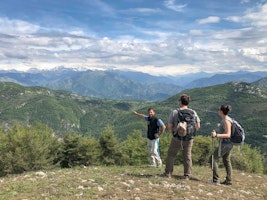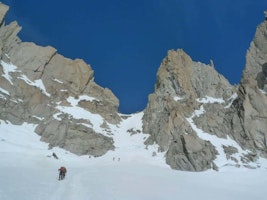Stretching through the stunning span of the Alps between Chamonix and Zermatt, the Walker’s Haute Route is one of the most popular treks in Europe and considered one of the 10 best hiking circuits in the world.
Starting from the shadow of Mont Blanc, hikers will spend a week or two climbing over elevated mountain passes, through picturesque alpine valleys, over massive glaciers and along the banks of colorful lagoons.
After exploring these varied landscapes, staying in idyllic mountain towns and taking in some of the best views Europe has to provide, hikers will reach the Matterhorn and descend to Zermatt, where the trip concludes.
Overall, hikers who take on the complete Haute Route can expect to hike over 200 kilometers and make a combined ascent of 15,200 meters. However, there are also shorter variations that involve taking public transport and lifts from one stage to the next.
Regardless of how you do it, heading out on the Walker’s Haute Route is certain to be an unforgettable experience. Take a look at some of the information that we’ve assembled below to decide how and when you will take on this hallowed trek for yourself!
How Long Does It Take to Hike the Walker’s Haute Route?
It traditionally takes 14 days to walk from Chamonix to Zermatt along the Walker’s Haute Route. However, among the most popular option is to make the trip in seven or 10 days. These shorter variations require taking a combination of buses, taxis or trains and chairlifts at certain parts of the trip.

Whether you have a week or two to spare, there is a perfect variation of the Walker’s Haute Route for you to experience! Photo courtesy of Emma Jack.
What’s the Basic Itinerary?
While there are several variations of the Haute Route, they all, more or less, follow the same path. (Days listed below are for the week-long version.)
Day 1: The adventure begins by hiking from Chamonix and through the Argentière valley towards the Swiss border. Hikers will finish off the day by crossing through two more valleys before descending down in front of the magnificent Triente glacier and into the Triente valley.
Depending on your time constraints, this can be done in one to three days. Taking a bit longer allows for several side trips, including an ascent of a nearby mountain to get some incredible views of the valley.
This section of the trail is also one of the busiest as it is also part of the Tour du Mont Blanc.
Day 2: After passing the idyllic mountain village of Champex-Lac, the trail branches away from the TMB and officially crosses into Switzerland. Hikers will pass by the village of Le Châble and begin ascending up toward Mont Forte and into the 4 Valleés area.
On a clear day, you will be able to see all the way back to Mont Blanc, an impeccable view.
Day 3: From here, the path continues at a fairly high elevation and hikers will climb through the rocky scree to Col du Louvie and cross the Col de Prafleuri, before descending into a small alpine valley.
After crossing the valley, hikers will ascend up the Pas de Chevres before staying at a nearby mountain hut for the night.
(Please note, longer itineraries will take a less direct route and travel this distance over the course of three or four days.)

Aside from Mont Blanc and the Matterhorn, there is plenty of stunning scenery to be discovered on the Walker’s Haute Route. Photo courtesy of Jon Dieguez.
Day 4: The trail continues, with a descent into an idyllic Swiss valley and passes by the shores of Lac de Moiry. The valley is full of traditional villages, which are worth stopping in and visiting.
After crossing the valley, hikers will make a steep ascent back up into the mountains that compose the Zinal ski area. From here, there are phenomenal views back into the valley and toward the Matterhorn.
Day 5: The trail continues to ascend up to the mountain pass of Forcletta, which boasts some of the best views of the entire trip. From here, hikers descend back into a valley before climbing up over the Augstbordpass and descending into the Mattertal valley.
We will get the best views of the Matterhorn on this picturesque day.
This part of the trail is also a bit more crowded than previous parts because it is where the Haute Route meets up with the popular Mattertal valley hiking circuit.
Day 6: The final day of the week-long itinerary is also the easiest. Hikers spend the day walking through the rest of the valley and on to Zermatt.
Please note this itinerary includes hiking about 30 kilometers each day or taking some public transport. Longer versions of the itinerary spend more time exploring different villages, valleys, and mountains along the way, but more or less follow this same route.
How Hard Is the Haute Route?
Hiking along the Haute Route is rated as an intermediate to hard trip, depending on the route that is taken.
On an average day, one will hike for six to eight hours and cover between 10 and 15 kilometers of distance with significant elevation gain. Overall, the journey is about 200 kilometers.
There are options that take higher paths and lower paths. The lower ones tend to be easier. There are also options to take trains and chairlifts in certain parts, which also cut down on the difficulty of the trek.

Expect to hike all day on the longer variations of the Haute Route, enjoying many sunrises and sunsets along the way. Photo courtesy of Anders Bahr.
Hikers willing to take the Haute Route need to have a fairly high level of physical fitness. Most guides will recommend fit participants to train for the trek by doing cardio and core strengthening exercises in the months leading up to the start of the trip.
Why Hire a Guide for This Trek?
While many hikers successfully complete the Walker’s Haute Route each year, it is always best to hire a certified mountain guide or leader for these kinds of trips.
There are parts of the trek that can be dangerous and traveling with a guide it the best way to mitigate these dangers. For example, there are several potentially hazardous spots including areas prone to rockfalls and narrow paths next to steep cliffs.
Your guide will have made the trek several times before, meaning he or she knows all the best routes at the trickiest spots, not to mention, where to find the best views.
Oftentimes, guides also make all the necessary reservations and deal with all of the details, such as transfers and lifts. All you need to do, meanwhile, is look forward to your trip and enjoy every moment of it while you are there.
How Much Does It Cost?

The people you meet and incredible natural beauty you experience on the Walker’s Haute Route is priceless. Photo courtesy of Sébastien Laurent.
Various factors figure into how much a trek along the Haute Route will cost. Depending on how long you trek, where you stay and how large your group is, prices per person vary considerably.
The rule of thumb would be to budget €2,000 per person. This should be enough for accommodation, meals, and transportation during the trip.
If you are traveling in a larger group, then this may decrease the price per person as well. Always remember to check with your guide for what their rates are as well as what is included in their prices.
When Is the Best Time for This Trek?
The best time to head out into the mountains on the Walker’s Haute Route trek is from mid-June through mid-September.
At this time of year, average daily temperatures hover around 15 ºC in the valleys during the day and become just a bit cooler at higher elevations. At night, temperatures can be quite cold.
Keep reading: Get ready to ski tour from Chamonix to Zermatt!
This part of the Alps is quite humid year-round, but summer tends to be one of the wetter times of the year, with an average of 10 to 12 days of rainfall per month. Bring rain gear.
July and August are the peak seasons to hike the Haute Route, so these are the busiest and most expensive months. Heading out on the trek in June or September is better for hikers on a budget.
Where to Stay While Hiking the Haute Route?
Most of the time while hiking the Haute Route, you will need to stay in mountain huts. These fill up quite quickly in the high season, so they must be booked well in advance.

Among the many highlights of the Haute Route is all the unique mountain huts you encounter along the way. Photo courtesy of Ella Alpiger.
When stages of the trip end in mountain towns or villages, then you will also have the option of staying in hostels and local bed and breakfasts.
For hikers on a tight budget, then camping is the cheapest option. There will be options to camp at several stages along the way, but not all of them. In Switzerland, wild camping is allowed as long as you leave no trace and are away from populated areas In France, wild camping is prohibited.
What Equipment / Clothing Do You Need?
In order to have a successful hike along the Haute Route, it is important to bring all of the correct gear. Below is a list of some of the things you should bring on your trip. Always confirm with your guide what he or she recommends you pack for this trip.
Recommended clothing:
Hiking boots (mid-ankle cut is recommended)
Rain pants and rain jacket
A mid-weight fleece sweater or soft-shell jacket
Synthetic hiking pants or shorts (1 to 2 pairs)
T-shirts made of polyester
1 pair of long pants
1 long sleeve shirt
3-4 pair wool or wool-blend hiking socks
1 pair extra trainers for wearing at the end of day and in town
1-2 casual outfits for dinner at mountain restaurants
Hat with a brim to protect from the sun
Gloves, headband, and a knit hat
Recommended gear:
30-liter backpack
1-liter water bottle or hydration bladder
1 pair trekking poles
Sunglasses
Small towel or microfiber sport towel, for use in the huts
Headlamp
Personal toiletries
Camera
Extra batteries
Passport
Insurance
Cash in Euros and Swiss Francs (many mountain huts don’t accept card)

The Haute Route finishes off in spectacular style with incredible sunrises over the Matterhorn. Photo courtesy of Emma Jack.
Regardless of when you go or which route you take, hiking the Walker’s Haute Route is an unforgettable experience. Take some time to look over the details of specific trips before booking your next hiking adventure.







